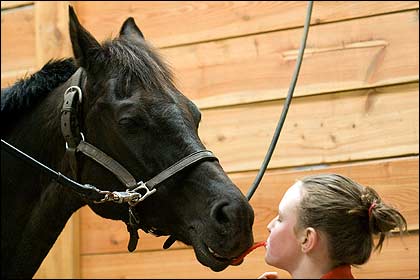Jump!
Horses, kids, water and ditches — what could go wrong?
By Camilla Mortensen
I couldn’t help but wonder if this was a good idea: Jumping 1,200 pounds of horse at a gallop over logs, walls, ditches and various and sundry large solid objects seemed a bit suicidal. “Just keep your eyes up and go!” trainer Karen O’Neal told me perkily as I got ready for my round. “Don’t look down. You’ll be fine.”
 |
| Sophia Statzer shares Red Vines with her pony after a good ride. Photo by Camilla Mortensen |
Turns out if you get a little adrenaline into my horse Flash and me, we’ll jump just about anything. Even the ditch. We came in fourth place. Flash sailed over the ditch like it wasn’t there while I clutched his mane and stared resolutely at the finish line. The rule in riding is: If you look at the ground, you’ll wind up there.
I was pretty proud of myself for my bravery until I chatted with 11-year-old Sophia Statzer. She totally outdid me on courage: “I love ditches!” she says. Her pony-sized Arabian named Allegiance “does a flying leap and it’s really fun!”
I was introduced to the sport of eventing (also called horse trials) about three years ago. I tried not to let it freak me out too much that the galloping cross-country portion of it requires that you wear not only a helmet and a medical armband, but also body armor.
Eventing has its origins in the military. It was a way for the cavalry to ensure its troops stayed fit and ready for battle. Only officers on active duty were allowed to compete in its 1912 Olympic debut. These days, three-day eventing and the other equestrian sports are the only Olympic events in which men and women compete against each other on equal footing.
The U.S. Pony Club is one way that kids begin competing in eventing. Sophia is a Pony Clubber and goes to regular meetings, where she learns not only how to ride but how to be safe and care for her pony. Her mom, Liza Statzer, is the joint district commissioner for Eugene’s Jumps and Jodhpurs Pony Club, and Sophia’s older sisters are long-time Pony Clubbers. You can participate in Pony Club from the moment you can get on a horse — Sophia was five when she started — until you turn 25.
Liza Statzer says that she gets a little tense sometimes, as she watches Sophia struggle to get Allegiance around a difficult course, the pony balking and even bucking. “I’m always like ‘Huulppp!’” she says, giving a demonstrative gasp, “and the kids are like ‘Mom! Stop!’”
But she says that watching her kids ride means she gets to see “that moment where they are like ‘Woo! I did this!’”
O’Neal, who lives in Sisters but travels to Eugene each week to teach lessons in the sport and once a month to coach the Pony Clubbers, has Olympic dreams. She was one of the nation’s top 50 riders last year, and she hopes to qualify for the 2012 Olympic games. Her mare True Avenue, an ex-racehorse she bought out of a backyard in Newberg, was second in the nation in 2009 at what’s called the Prelim level and was a top 10 mare overall. “She’s just amazing,” O’Neal says.
O’Neal explains that in eventing, “You have to really ride and be versatile. You have to take an extremely fit animal and make it look like a relaxed being.”
The first day of a three-day event is dressage. Think of this as horse ballet or figure skating. Judging is based on the way the horse and rider execute a pattern of movements with elegance and precision.
The second day is cross-country, Sophia’s favorite part: “I like going through water and getting to gallop.” Horse and rider jump a long outdoor course of solid obstacles from plain old logs to jumps designed to look like anything from a small airplane to a chicken coop.
Cross-country developed a reputation for danger after 12 riders died in falls in 2008. The main danger is in what’s called a rotational fall: The horse, going at a high rate of speed, hits a jump with its chest or front legs and flips over the jump, sometimes landing on the rider.
Since 2008, the United States Eventing Association has developed a new set of safety regulations as well as some fences that are designed to give way if a horse hits them.
On the third day the horse-and-rider pair competes in stadium jumping where they are asked to show their dexterity and stamina jumping a course of brightly colored fences, losing points if a tired horse knocks down rails or refuses a jump.
At higher levels, there are veterinary inspections during the course of the event to ensure the horse is in good enough shape to continue.
“Both horse and rider have to be really fit,” O’Neal says.
Tell me about it. After O’Neal was done with Flash and me, we were both dripping sweat but ready to go to the next horse trials. Eyes up; heels down. Keep the horse between you and the ground …
From June 25-27 there will be a three-day event in Philomath featuring riders from pint-sized Pony Clubbers to Olympians. For more info go to www.inavalefarm.com and for more info on Pony Club go to www.ponyclub.org useventing.com will bring you up to speed on the eventing world.
Does a Hippie Trip in the Woods? Drug use in the great outdoors
Jump! Horses, kids, water and ditches — what could go wrong?
Petanque Get the balls rolling